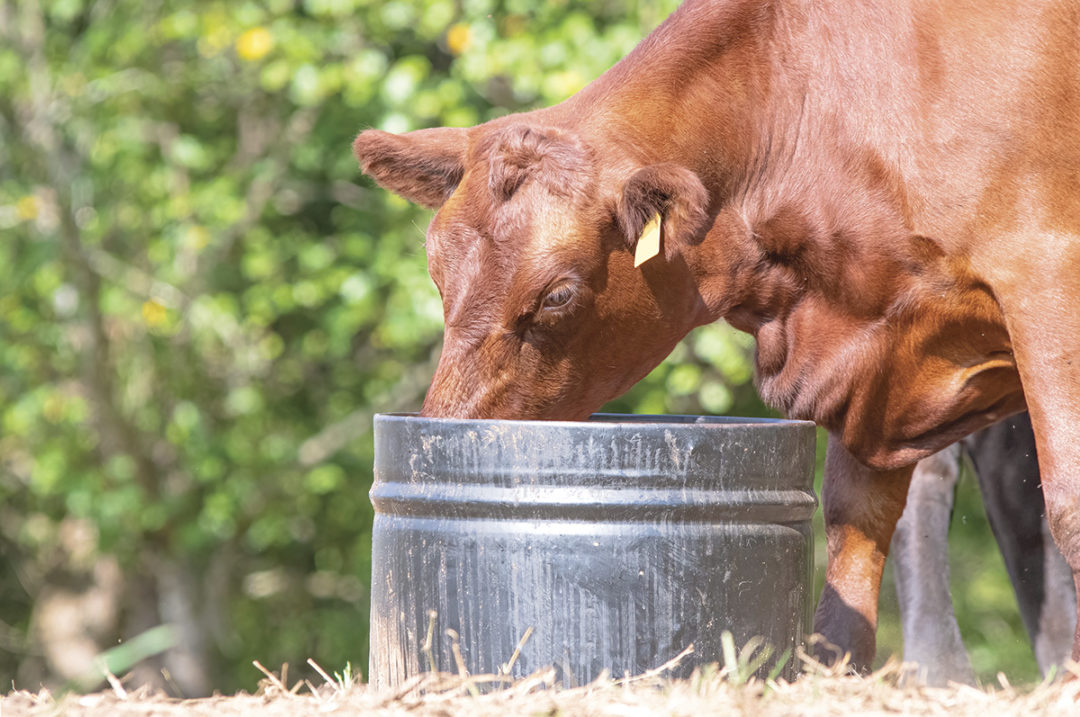Input costs for all of agriculture have continually risen, which means we need to make sure we are getting the most out of every dollar spent. Feed costs for beef production are the largest expense on a ranch. Included in feed costs are hay, supplement and mineral. How do we know these inputs we are feeding our cows are working? There is no better time than now to start an annual plan of monitoring feed inputs, so you can know you are getting the most out of them and what is best for the animal.
Feed ingredients
Pasture, harvested forages and water should be evaluated every year. Feed tests should include macronutrients (protein and energy), macrominerals (calcium, phosphorus, potassium, magnesium), as well as trace minerals (copper, zinc, manganese, selenium, iron and molybdenum). Often, trace minerals are excluded from feed testing. However, this is a mistake. When mineral can cost $1,300 per ton or more, don’t you want to know it is the right mineral for your situation? Without trace mineral testing of feeds, you will never know.
Additionally, water evaluation should be a part of this plan. There could be trace mineral antagonists (mainly sulfur or sulfates) in water as well as elevated levels of salts that could negatively impact free-choice mineral consumption. Having a baseline understanding of potential trace mineral deficiencies and antagonists is critical to ensure you have a starting point for what your mineral supplementation targets should be. Furthermore, it is a small economic investment to provide enough copper, zinc and manganese in the supplement from an improved trace mineral source to meet the animal’s requirement and use the basal dietary supply as the extra safety factor to overcome an antagonist or deficiency.
Animal nutritional status
It is easy to monitor the success of macronutrition (protein and energy). You can use body condition scoring (BCS) to evaluate cow status. This tool allows you to know whether you need to adjust your feed up or down based on how the cows look. It gets a lot harder to monitor if your macromineral and trace mineral nutrition is working. There are no visual observations with subclinical mineral deficiencies. By the time you see something, it is too late, and a wreck is about to happen.
Because of that, a mineral monitoring plan should be put in place. The best way to accomplish this is to start a liver biopsy program. Pick a small group (eight to 10 head) of cows that are in a similar age bracket (all mature cows or all young cows) and conduct liver biopsies at pregnancy check time (start of the last trimester). This will allow you to see what the cow’s status is and give you time to adjust if they are low. The liver is the main storage mechanism for many trace minerals; it is like the gas tank of the animal. This testing will let you see if the tank is full or empty.
The last trimester is also a critical time for the fetus, and it has high demands for trace minerals. If the fetus does not get enough nutrients, the calf will more than likely have health and production issues its whole life. Most veterinarians will be able to perform the biopsy, and it is safe for the animal.
Monitoring watchouts
When using liver biopsies as a monitoring tool, there are some things to be aware of. First, do not biopsy too close to calving. The fetus takes a significant amount of copper from the dam, and if you test close to calving, the cow may appear deficient. However, this could simply be because what she is eating is going to the fetus and not to her own storage. Ninety days pre-calving would be an ideal time. Additionally, make sure only healthy animals are biopsied. Sometimes there is an urge to look at mineral status of a sick animal or one that is close to home and easy to get to. Health status can affect trace mineral levels in the liver and not give a real representative analysis of the herd.
Also, avoid sampling a recently deceased animal. If an animal dies for unknown reasons and a necropsy is performed to take tissue samples to determine cause, liver mineral testing is sometimes part of that evaluation. Mineral evaluation postmortem will not be accurate. Mineral status of the deceased animal can be two to three times higher than what it was before it died. Avoid this testing.
Finally, make sure the diagnostic lab samples are sent to report the result on a dry matter basis. When feed samples are tested, results are generally reported on a dry matter basis; liver biopsy results should be no different. When it comes to a biopsy, we are only concerned about the nutrients and minerals without the water.
Making it work
Once you have feed analysis and liver biopsies performed, how do you put it all together? Excel spreadsheets are a great tool. Plug feed analysis into a tab, and over time you can see historic averages and use that as your baseline for planning which feeds should go to which cows. This can also provide trace mineral averages so you know how much supplemental mineral is needed and what the feed tag should look like when you make your free-choice mineral purchases. Liver biopsy results can be plugged into another tab. It is easy to graph this out over time to get a good visual of where your herd’s status is. These can then be monitored year to year to make sure what you are buying is working and if any adjustments need to be made.
You can’t monitor what you don’t measure. Some simple feed and liver testing can really help a ranch make sure every dollar spent is doing what it is supposed to be doing.










